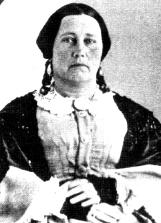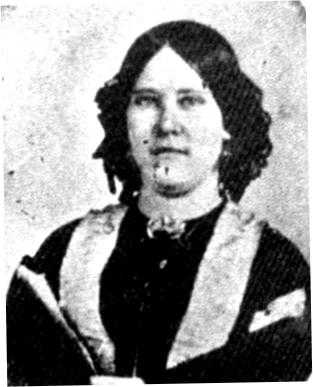

SUSANNA WILKERSON DICKINSON
(1829-1883)

ANGELINA ELIZABETH DICKINSON
(1834-1871)
It is sometimes said that life in the early days of Texas was anadventurefor men and dogs, but hell on women and horses.
Susanna Wilkerson Dickinson will always be remembered as the sole adult Anglo survivor and the most extensively quoted eyewitness source (though not necessarily the most reliable) to the final and subsequent events surrounding the massacre at the Battle of the Alamo.
Susanna was born in Williamson County, Tennessee about 1814 as Susanna Wilkerson. On 24 May 1829, at the age of only fifteen years, she married twenty-year-old Almaron Dickinson. Within two years, the young couple arrived in Texas settling in the DeWitt Colony in 1831. Almaron Dickinson received a league of land on the east bank of the San Marcos River below the Old Bexar Road in Caldwell Co acquiring property in inner Gonzales town in 1834. There he set up his blacksmith shop and went into partnership with George C. Kimble in a hat factory. The couple's only child, a daughter, Angelina Elizabeth, was born there on December 14, 1834.
The Battle of Gonzales in the fall of 1835 marked the beginning of the Texas Revolution. Dickinson was among the original 18 defenders of the Gonzales cannon and was in charge of the cannon during the confrontation. Almaron joined a group of volunteers to help secure San Antonio for the Texans and served as an aide to General Edward Burleson during the Siege of Bexar . Susana stayed behind with Angelina.
However, after her home was looted a few weeks later by members of an East Texas militia company, Susanna decided to join her husband in San Antonio. The family set up residence in the Musquiz house on the southwest corner of Portero Street and the Main Plaza, but when Mexican troops arrived in San Antonio on 23 Feb 1836, Dickinson moved the family into the Alamo.
Because she was only 15 months old at the time of the siege, their daughter, Angelina in later years became known as the "Babe of the Alamo." Before his death, Colonel William Barret Travis gave to the infant a ring that had been a gift from his sweetheart Rebecca Cummings.
After the fall of the Alamo, Santa Anna interviewed Susanna, accompanied by her infant daughter and the other female survivors. The general gave each a blanket and two dollars in silver before releasing them.
Legend says Susanna displayed her husband's Masonic apron to a Mexican general in a plea for help and that Santa Anna offered to take baby Angelina to Mexico. Santa Anna sent Susanna and her daughter accompanied by Juan N. Almonte's servant, Ben, and William B. Travis's freed slave, Joe, to Sam Houston with a letter of warning dated March 7. After heading eastward from San Antonio, Deaf Smith and Henry Karnes, scouts for the Texas army found the travelers and they were taken to meet Houston in Gonzales.
Without skills, illiterate and only twenty-two years old when Texas independence was won, Susanna requested but was denied a $500 government donation forcing her to live in poverty.
In the years that followed, Susanna suffered through several stormy marriages. She married John Williams in late 1837, but his abusiveness prompted their divorce by March 24 of the following spring.
She then married Francis P. Herring who died in 1843. This marriage was followed by her union to Peter Bellows. She divorced the latter after he charged her with adultery and prostitution. The divorce petition accuses her of taking up residence in a "house of ill fame." Indeed, before her marriage to Bellows she may well have taken up residence in the Mansion House Hotel of Pamela Mann, a known brothel.
Despite these accusations, Susanna received praise from the clergy for her work nursing cholera victims in Houston.
In 1857, Susanna married German emigrant, Joseph William Hannig . This was her fifth marriage, but a stable and happy one. The couple soon moved to Austin, where Hannig ran a successful cabinet shop and furniture store.
Until her death in Austin on October 7, 1883, Susanna was active in relating her experiences in the Alamo and commemorating its heroes wherever she could find an audience.
Susanna Dickinson's Recollections of The Alamo Siege
Susanna Dickinson originally stated she stayed in one of the rooms of the Alamo church and did not see any of the siege or final assault. Later, when she was rediscovered by the press and sensationalist writers, she continuously changed her "recollections" to fit whatever new story was in fashion.
The gist of what she reported:
- There were minimal casualties before the final assault.
- On the morning of the assault her husband told her the Mexicans were over the walls and ran out. She never saw him again.
- She hid in a room of the chapel and did not see the battle. One defender ran into the room, followed by Mexicans who tossed him on their bayonets. (One interview mentioned the same fate for two small boys who also ran in.)
- A Mexican officer intervened, either an English mercenary named Black, or Almonte.
- Outside, there was a single survivor, who unsuccessfully begged for mercy.
- She saw the body of Crockett between the chapel and the barrack building.
- She saw the body of Bowie, and he had shot two Mexicans from his bed before dying.
- Travis died working a cannon on top of the church. (Crockett's body she could not have avoided, but she did not say how she saw that of Bowie and Travis.)
- She was taken to a house she had lived in prior to the siege, and saw the smoke of the pyres.
- The next day she was taken before Santa Anna, who was talked out of imprisoning her by Almonte.
- She was sent east on a pony, with a black man whose name she gave variously as Ben or Joe. (She may have been too shaken to notice they were two individuals.) A party led by Deaf Smith found her on the way to Gonzales.
- The Alamo housed a hospital for wounded from the siege of Bexar, with about 75 disabled men.
- At some point, she lost her mind and wept for days.
- Only three men entered the fort during the siege.
- Juana Alsbury defected to the Mexicans with her sister.
- There was only one man in the fort named Rose.
- She claims to have watched the line-in-the-sand incident from the door of the chapel -- but the chapel courtyard would have been too small for the gathering.
- That the line-in-the-sand incident supposedly happened the evening before the assault, and the one hold-out was found missing the next morning. (Indicating that they held roll-call before the assault, in her presence. Doubtful)
- After the siege, Col. Almonte said the holdout had been killed while trying to escape and offered to show her the body, but why would Almonte care?
- In another interview she implied that the line-in-the-sand incident happened on the first day of the siege.
The story of William Travis drawing a line across the courtyard didn't surface until the 1870s, when William Zuber claimed to have heard it from Louis Rose, the one who is supposed to have refused to cross the line. But there is no other record to support the story. The fact that Susanna related this story as an eye-witness account, only diminishes her credibility.
See Also: